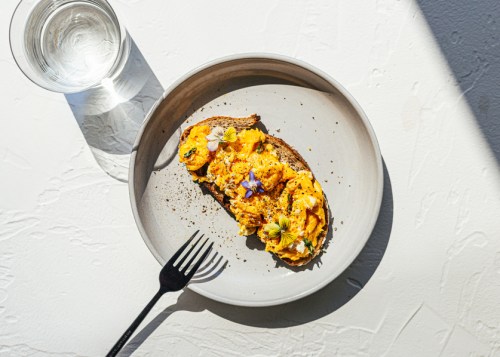‘I’m a Food Scientist, and Here’s Why Adding Water Is Key for Cooking the Fluffiest Scrambled Eggs’
A pro chef explains why scrambled eggs with water are fluffier than those with milk, plus how to make restaurant-quality versions at home.

Like many folks, Sam Davis-Allonce learned to make scrambled eggs from watching her mother as a child. But unlike almost everyone else, she went on to become a professional chef, making it her business to know the best techniques for cooking anything, including eggs. “Growing up, I lived in a house where milk was always added—it makes your eggs a little creamier,” says the Harlem-based chef, caterer, and founder of the plant-based hot sauce company Hot N Saucy. “But when I started cooking, I realized that water was definitely the way to go.” You see, making scrambled eggs with water creates cloud-like, restaurant-quality results that deserve all the chef’s kiss emojis.
Experts in This Article
UK-based food scientist and CEO of Nali Consulting
Sam Davis-Allonce is a professional chef, caterer, and founder of the plant-based hot sauce company Hot N Saucy.
“By adding water to eggs, you’re preventing the proteins from binding too quickly,” says London-based food scientist Natalie Alibrandi. “The water creates steam when heated, and the result is a fluffier texture.”
Thankfully, you don’t need to be a scientist or a professional chef in order to make scrambled eggs with water at home, but you do need to be mindful of your measuring. “If you add too much water, your eggs will be runnier and more diluted in flavor,” Alibrandi explains. For best results, Davis-Allonce recommends using a half teaspoon of water per egg if you prefer to a hard scramble, meaning all the liquid is cooked off. Meanwhile, Alibrandi says one to two teaspoons if you prefer your scrambled eggs on the softer side, which means they’re a little wet. (This is typically how you’d see scrambled eggs in Europe, says Davis-Allonce.)
How to make scrambled eggs with water like a professional chef
Before getting into details, Davis-Allonce is quick to note that how you cook eggs really comes down to personal preference. “It’s not gospel,” she says. “But this is how I do it.”
1. Crack eggs into a mixing bowl with half a teaspoon of water per egg (or a little more for a softer scramble) and add a pinch of salt.
2. Whisk the eggs with a fork or whisk. “Just make sure it gets really incorporated and the yolks are broken” she says. “I whisk my eggs until I see little bubbles in the bowl because that’s how I know that I’m getting air into them, and that adds to the fluffiness.”
3. While you’re whisking, place a skillet (opt for a non-stick frying pan if you can) on the stovetop over medium heat with either a tablespoon or cooking oil or pad of butter. “This is another point of egg contention,” Davis-Allonce says in reference to how you choose to grease your pan—the correct choice being your favorite. Davis-Allonce likes olive oil, as do some of the longest-living people on the planet.
4. Pour the incorporated eggs into the heated skillet and use a spatula sparingly to stir. “Some people use a spoon, again, old school,” she says. “My mom used a pancake spatula; that’s what she liked. What you grew up with isn’t necessarily wrong—it’s a comfort thing.”
5. Cooked to your desired level of scramble—hard, medium, or soft—and enjoy hot off the skillet.
Need more reasons to love eating eggs for breakfast? Learn why an RD calls them ‘nature’s multivitamin’ by checking out this video:
Oh hi! You look like someone who loves free workouts, discounts for cutting-edge wellness brands, and exclusive Well+Good content. Sign up for Well+, our online community of wellness insiders, and unlock your rewards instantly.
Sign Up for Our Daily Newsletter
Get all the latest in wellness, trends, food, fitness, beauty, and more delivered right to your inbox.
Got it, you've been added to our email list.










